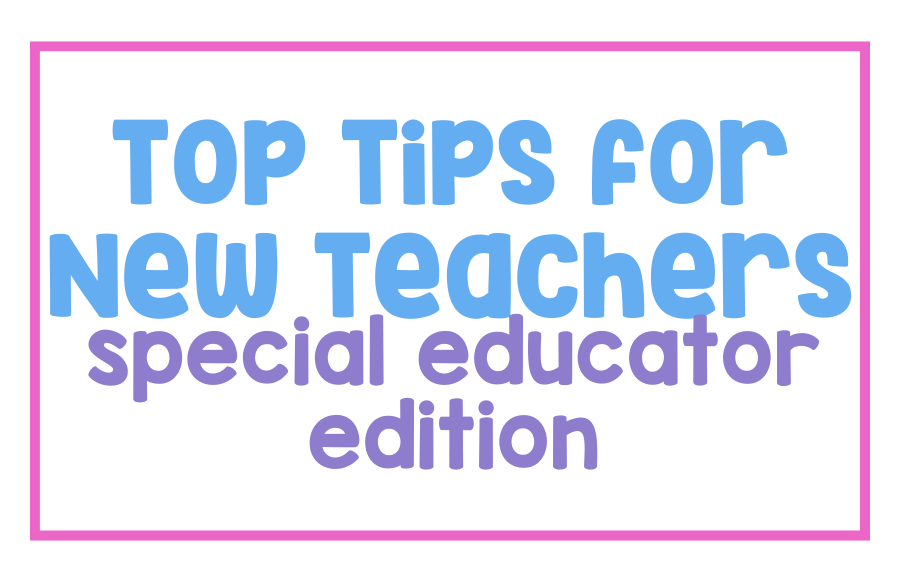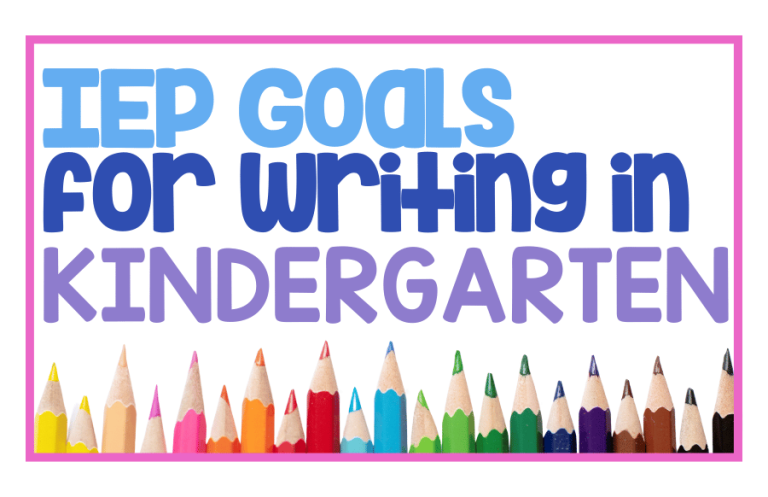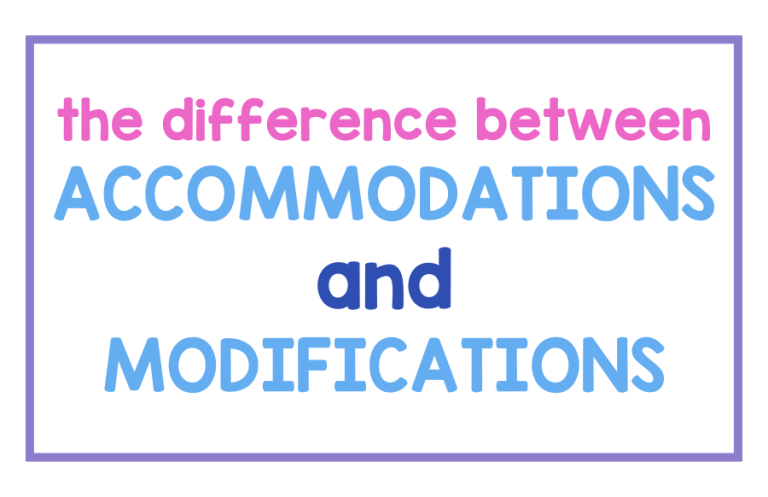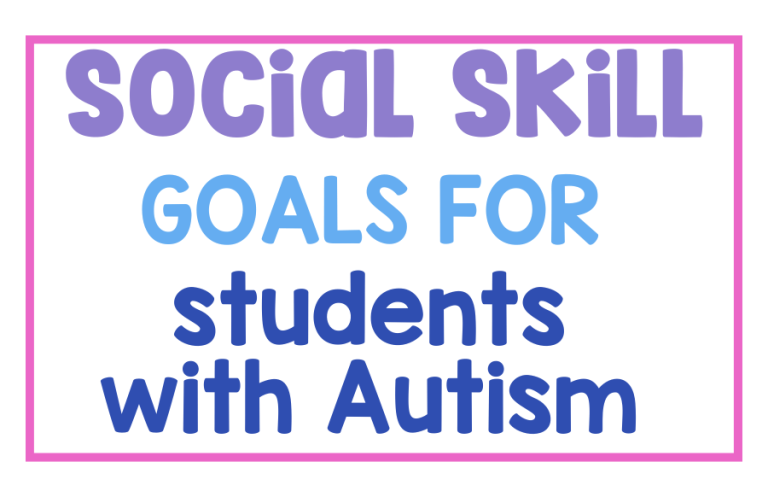Top Tips for New Teachers: Special Education Edition

Your first year of teaching is wild ride. Equal parts exciting and “what did I just sign up for?” The truth is, no amount of college classes or Pinterest boards can prepare you for the moment you’re standing in front of a classroom of kids you’re responsible for. First-year teachers need all the support they can get, but in the school system, it can kind of feel like you’re being thrown to the wolves.
You’re now responsible for all data, running IEP meetings, tons of paperwork, legal deadlines, classroom management, parent communication, lesson planning, co-teaching, recess duty…and that’s just before noon!
If you’re overwhelmed just reading that, you’re not alone! The most important thing I want you to remember is that it’s important to be prepared, but you also get to do things your way and will change them as you go!

OVERLOADED caseload? No idea how you are going to manage it all? This Summit is for you.

calling all SPED Teachers
OVERLOADED caseload? No idea how you are going to manage it all? This Summit is for you.
There’s no way the systems and processes I put in place my first year teaching are the same as the ones I use now. Not to mention how much I’ve learned over the years.

Your own experiences will guide you throughout the years, so don’t worry about being “perfect.” No one expects you to be amazing at this new job. But, there are definitely a bunch of tips and tricks that I can give you to help you feel more confident going into the upcoming year.
I’ve broken this blog into 5 categories I find make the biggest difference for new teachers: systems, managing behavior, staying organized, managing paras, and taking care of yourself.
Truly though, even if you’re a veteran teacher, this list is great to come back to!
Systems You Should Have in Place
One of the biggest lessons I learned early on was this: systems save you. The more you can make routine tasks automatic, the more energy you’ll have for your students and yourself at the end of the day. Now, in the beginning, I used to try out a new system every other week…don’t do that!
While you may start with a system and think there is a better way, I urge you to stick with it for a good chunk of time. If you want to change something in a couple months because it really isn’t working, that’s fine! Just don’t get stuck in the shiny object system trap. You’ll have even less time to get everything done if you’re wasting it re-doing your systems every Monday. Trust me.
Here are the areas you should focus on creating systems so that you can teach students from day 1.
1. Classroom routines:
Start with the basics: how students enter, how the day begins, and how the day ends.
Having things in place like a morning check-in chart or a simple visual schedule can make transitions smoother and give students a predictable rhythm. Here is a morning check in to get you started (plus it is digital so zero prep)

Ending the day with a pack-up routine or reflection activity also builds independence depending on if you have kindergarteners or high school students
It doesn’t really matter exactly what your system is, just that you and your students know exactly what it is!
2. Documentation systems:
Data collection is non-negotiable in special education. It will be the thing you live and breath: data.
My best advice: Keep it simple and consistent. Whether you use a binder with tabs, sticky notes that transfer to a spreadsheet, or an app, choose one method and stick with it.

You want to make sure you have this system dialed in and solid because not only will you use this data to drive your instruction, you’ll also share it with parents and the student’s IEP team.
I liked having individual clip boards for students with data sheets ready to go for the week.
If you use a system like this, just make sure your system includes printing extra data sheets regularly and your process for what you’re doing with the data once it’s taken. Are you inputting it digitally? Are you putting data sheets in a binder?
3. Collaboration systems:
If you work with paraprofessionals or co-teachers, create shared systems right away.
A binder or digital folder with IEPs, visuals, and role expectations helps everyone stay on the same page. I had a folder for each student and within that folder, I’d share the accommodations and modifications list, their goals and objectives, and any behavior management supports.
It was so helpful to set these folders ahead of the new school year and share them with specials teachers and general eduction teachers so they have time to review.
Just make sure to update these folders as you create new IEPs!
Clear communication upfront prevents misunderstandings later.
Ways to Manage Behavior
Behavior management is probably the most important aspect of a special education teachers day. Because when student behavior is less disruptive, they learn more, you get more done in your day, and everyone enjoys school so much more, right?
However, it can feel overwhelming, especially when every student have unique needs and are lacking skills in this area.
One thing I’ll remind you of here…your goal isn’t perfection, it’s consistency.
1. Set clear expectations:
Students thrive when they know exactly what’s expected. Use visuals, role play, or social stories to explain routines and rules. And keep explaining them! Be consistent in reinforcing those expectations. Here is a visual starter pack for you if you are looking for a one stop shop to start with!

2. Focus on the positive:
Praise and encouragement go a long way. It not only helps you manage your own classroom well, it also helps you build solid relationships with your students.
Catch students being successful and let them know you see it. Token systems, choice boards, or reward menus can also be powerful motivators when tailored to your students’ interests and needs. Here are some free token boards for you to try out!

3. Plan for de-escalation:
Even with great systems, tough moments are going to happen-it’s unavoidable. Have calming supports, sensory tools, or quiet break options ready. Be able to let academics go during these times and stay focused on regulation.
My Social Emotional Visual Supports and Activities can help you practice regulation skills with your students so they know what to do when they have big feelings.
When things do get a little tricky, remember to keep your tone neutral, your body language calm, and remember that you’re modeling how to handle those feelings too. That best practice will save you!
4. Relationships first:
Behavior improves when students feel connected. It doesn’t take an experienced teacher to build a solid relationship with their students.
All it takes is intention.
Learn your students’ interests, greet them by name, and celebrate their victories (even the small stuff). When students trust you, they’re more willing to meet expectations.
How to Stay Organized
Organization isn’t about being Pinterest-perfect, although that’s always a dream, right?. It’s about creating systems that help you find what you need when you need it.
The systems below will help you keep everything from lesson plans to IEP paperwork organized. Good teachers are able to find the things they need when they need them.
Now, I have seen less-than-organized classrooms where the teacher knew exactly where everything was. But organized chaos doesn’t work for most people. So, let’s dive into the best way I know to stay organized.
1. Physical organization:
Color-code materials by subject or by student. I was a big fan of each student getting a color! I would put colored paper over the IEP data clipboards so I could easily identify them, and have colored bins with materials for them. It was a quick and easy way to keep things organized.
You should also label all your material bins for adapted books, manipulatives, or visuals. This will save you from digging through piles.

2. Digital organization:
Use one hub for your digital files. Whether it’s Google Drive or OneDrive- keep IEPs, data sheets, and parent communication logs in one spot.
Name your files clearly and stick with your system!
3. Time management:
Batch prep materials once or twice a week so you’re not scrambling every morning. You may not know your teaching style or your planning style yet, but either way, you’ll time dedicated to prepping.
I liked using Thursdays as prepping day for next week. That way if I missed it because of a student behavior or something, I still had Friday as a back up.
Managing Paraprofessionals
If you’re working in special education, chances are you’ll have paraprofessionals (paras) in your classroom. They’re so important and an incredible support system for both you and your students, but only if you take the time to build clear expectations and a strong team dynamic.

1. Set clear roles:
Don’t assume your paras automatically know what to do. This can be tricky as you’re still learning too, but take time to explain routines, student needs, and what support looks like during lessons.
A simple “cheat sheet” or binder with key info can be a lifesaver.
2. Communicate openly:
Check in regularly and don’t wait until something becomes a problem. It’s awkward, but feedback is vital. Quick conversations before or after school, or even a shared notebook or chat app, are a great way to keep everyone on the same page.
3. Model and guide:
Your paras will follow your lead. Model how you want students supported.
Whether it’s prompting during small groups, handling behavior, or using visuals. Gently coach and give feedback so they feel confident in their role.
4. Show appreciation:
Paraprofessionals often do some of the hardest, most hands-on work in the classroom. A simple thank-you, a handwritten note popped into their mailbox, or just recognizing their efforts goes a long way in building a positive working relationship.
P.S. This is the most important one.
Prioritizing Self-Care
It’s easy to pour all your energy into your students and have nothing left for yourself. But burnout helps no one. You’ll be a better teacher when you take care of yourself. As a first year teacher, you’ll be working harder because everything is new and you’re building your materials, learning new curriculum, etc.
Your hard work needs to be met with acts of self-care.

Here’s how.
1. Emotional self-care:
Give yourself grace. You’ll make mistakes, and that’s okay.
Talk through challenges with a mentor or write them down to process. Student behavior, hearing about student traumas, and having tough parent conversations can feel heavy. Make sure you have a way to unload and process.
2. Physical self-care:
Keep snacks and water at your desk! Don’t go a whole day without taking a sip of water. It’s easier than you think to stop drinking your water.
That snack drawer will be a life-line. Bonus points if you have a secret chocolate drawer for you and your paras!
3. Work-life balance:
Set a time to leave school each day. The work will still be there tomorrow. Protect your evenings and weekends as much as possible. This will be tough in the beginning you’ll show up stronger for your students when you’re rested.
Final Thoughts
Your first year as a special education teacher will be full of challenges, no doubt, but it will also be full of growth and moments that remind you why you chose this path.
No matter what grade level you teach, you don’t have to know everything on day one.
Start with systems, build relationships, and give yourself grace along the way.
Remember: you’re not just teaching skills—you’re building confidence, independence, and belonging for every student in your care.
And that’s work worth showing up for every single day.






